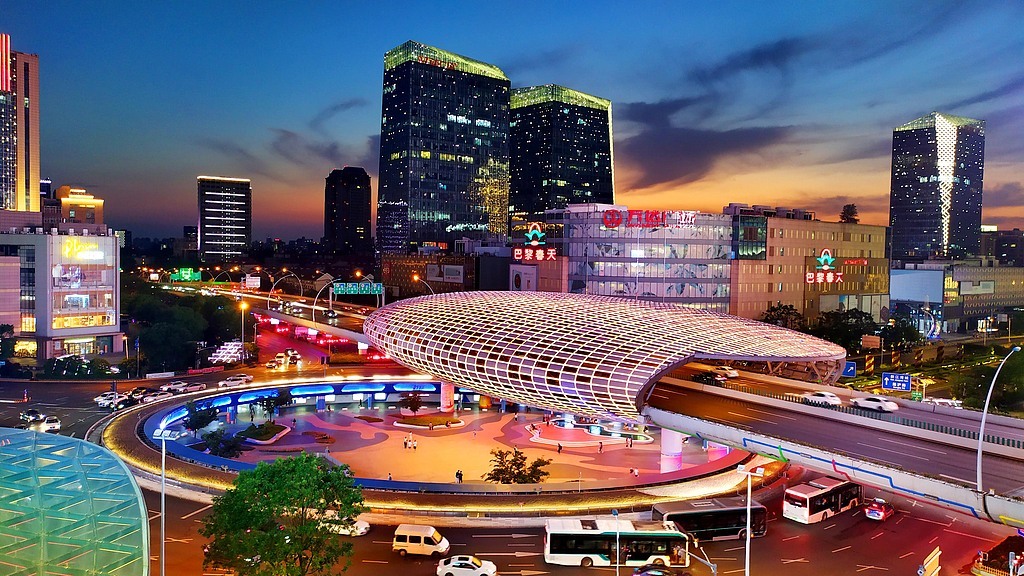
Tranalysis
The glass curtain wall of Jinsui Building reflects the flowing clouds of Lujiazui, this 30-year-old building has been rejuvenated through digital transformation; a stream of people pass by the front of Hongqiao Tiandu, with the rental rate of the renovated space exceeding 85%; the newly installed elevators in Yuan Building quietly transport white-collar workers, with an investment of more than 2 million yuan each time, resulting in reduced energy consumption and a leap in efficiency...
In China's largest economic center city, Shanghai, urban renewal actions are being fully rolled out in the field of commercial buildings.
The executive meeting of the municipal government held on June 10th agreed in principle to the \Implementation Opinions on Promoting the Renewal and Upgrading of Commercial Buildings in Shanghai\ and pointed out that commercial buildings are important carriers for carrying the core functions of the city and demonstrating the level of modern development. It is necessary to focus on leading by example, and accelerate the creation of demonstration benchmark projects.
In early July, the Shanghai Municipal Planning and Natural Resources Bureau announced the first batch of five major business unit renewal plans - Hongqiao Economic and Technological Development Zone, Caohejing, Wujiaochang, Da Baishu, and Zhenru collectively ushered in transformation, marking the official entry into the practical implementation phase of the \Shanghai Action Plan for Promoting the Renewal and Upgrading of Commercial Buildings (2024-2027)\ released in June 2024.
As the largest office building market globally, Shanghai has over 10,000 high-rise buildings. Official statistics show that the stock of Grade A office buildings reaches 17 million square meters. The business skyline of this city is undergoing a quiet yet profound self-renewal.

Shanghai Wujiaochang business district The pictures in this article are all visual China material pictures.
The inevitable choice in the era of stock
Why does Shanghai need to put in a lot of effort to promote the renewal and upgrade of commercial buildings at this particular juncture?
The recent Central Urban Work Conference set the tone, \China's urbanization is transitioning from a period of rapid growth to a period of stable development, and urban development is shifting from a stage of large-scale incremental expansion to a stage primarily focused on improving the quality and efficiency of the existing stock.\ Shanghai is no exception.
At present, Shanghai's commercial real estate market has transitioned from an era of growth to an era of stock, with some office buildings experiencing increased vacancy rates. The renovation of old office buildings has also become an inescapable issue.
For instance, many buildings in Lujiazui and Hongqiao Economic and Technological Development Zones were constructed in the 1980s and 1990s, and office buildings developed in the early years of this century in the Huangpu core area, North Bund, and Xujiahui are also \past their prime.\ Issues such as outdated design, aging equipment, and insufficient parking spaces are concentrated. In our country, the maximum land use term for commercial and office purposes is stipulated to be 40-50 years, and the remaining land tenure for these buildings is generally less than 15 years, making the pressure for renewal imminent.
According to the preliminary investigation by government departments, there are a total of 36 buildings in Lujiazui within the scope of Weifang New Village Street. Among them, there are 8 buildings with glass curtain wall designs exceeding 25 years, and 5 buildings nearing their design life (20-25 years), which means that 65% of the building exteriors are in urgent need of renovation.
Additionally, the old elevators in these buildings have been in use for almost 30 years, such as the Yu'an Building, which was completed in 1995. In recent years, incidents of \elevator trapping people\ have started to occur intermittently in the building. Since these elevator equipment have been discontinued, it is no longer a simple matter of repair; they must be renovated.
The dispersion of property rights is also a major challenge in renovation and upgrading. Taking Bao'an Building as an example, 60,000 square meters belong to the major owner, while 30,000 square meters are scattered among multiple minor owners, and the renovation plan is repeatedly shelved due to disagreements on the allocation of funds. The fragmented property structure has trapped nearly 30% of the existing buildings in a cycle of \obsolete functions - decreased valuation - lack of renovation effort.\
For example, one of the biggest challenges in the renovation of the New Hongqiao Center Building, which has been in operation for 27 years, is that the property rights are divided among more than 30 units. Faced with the huge financial investment in building renovation and the long investment return cycle, owners of all sizes are taking a wait-and-see attitude.
Of course, local governments are also well aware of the pressure that property rights issues bring to building renewal, and they need to focus on solving them. For example, the \15th Five-Year Plan for the Development of the Central Hongqiao Area in Changning District\ emphasizes that for building projects in the period of property rights and equity adjustment, such as the podium of the New Hongqiao Center Building (formerly Jisheng Weibang), the World Trade Mart, and the Friendship Mall, both the buildings and the local governments should actively communicate and coordinate the issues encountered in the process of property rights adjustment.

Shanghai Caohejing Development Zone
System engineering for targeted strategies
Facing the aforementioned multifaceted pressures, Shanghai has included building renewal in its 8.0 action plan to optimize the business environment. The deep logic of this renewal is reflected in the systematic planning of the \Shanghai Action Plan for Promoting the Renewal and Upgrading of Commercial Buildings (2024-2027)\. The plan clearly states that by 2027, 40-50 renewal projects will be completed, reconstructing the ratio of Grade A, Grade B, and Grade C buildings.
At the same time, Shanghai has chosen an innovative path of differentiated policy implementation. In fact, in July 2024, Shanghai announced the first batch of 6 major business unit renewal plans covering the central area of the middle ring, with a total area exceeding that of Huangpu District, involving more than 200 buildings.
Based on the current condition of the buildings and the intentions of the property owners, the upgrading and enhancement of buildings are divided into three categories: quality improvement, renovation, and reconstruction. Among them, super-grade A buildings focus on quality improvement, which means introducing leading enterprises to enhance the concentration of business formats and output intensity; Grade A and Grade B buildings focus on renovation, including improving operational service quality and promoting the integration of functions; Grade C buildings are suitable for the reconstruction strategy.
The essence of this grading and classification strategy is to precisely match resources with needs: super-grade A quality improvement, anchoring global competitiveness; Grade A/B renovation, activating existing value; Grade C reconstruction, resolving inefficient supply. Its innovation lies in upgrading building renewal from hardware renovation to a systematic project of economic function reconstruction, property rights mechanism breakthrough, and regional collaborative development.
By 2027, the wholesale renewal of 40 business units may reshape the underlying logic of Shanghai's building economy—from \single container\ to \ecological cell.\ The core lies in breaking the rigid boundaries of traditional commercial office spaces to adapt to diverse needs with flexible functions.
The renewal of buildings in Shanghai is by no means a simple physical space renovation; instead, it employs systematic thinking to reweave architecture, industry, people, nature, and urban functions into an organic living entity. It transcends the traditional scope of \building repair\ by achieving a qualitative change in ecological reconstruction through five dimensions: spatial function integration, green technology penetration, community network activation, digital gene injection, and governance mechanism innovation.
For example, the Caohejing implementation plan proposes four major strategies: \building quality improvement and renewal, public space quality improvement, service facility implantation, and operational empowerment enhancement,\ integrating individual renewal into the upgrade of the regional ecosystem.
The temperature of Shanghai's building renewal is more reflected in the ultimate attention to people's experiences. In the publicized plan, Hongqiao plans the \Backstreet Experience Loop,\ connecting the international community atmosphere of Golden City Road with the \eternal night Xianha\ night economy; Caohejing constructs a \slow traffic system,\ focusing on improving the walking experience on roads such as Yishan Road; Zhenru lays out \five major types of living support\ - all designs serve to enhance people's comfort and convenience.
It can be seen that these update items all follow a common update logic: adapting to local conditions for functional positioning.

Shanghai Hongqiao Economic Development Zone
The dual magnetic field of industry and talent
The recent Central Urban Work Conference included \urban renewal\ in its overall requirements, emphasizing structural optimization and functional transformation. Shanghai's practice is a vivid interpretation of this strategy.
Shanghai's building renovation is evolving from mere spatial transformation to a systematic reconstruction of industrial and talent ecosystems. By diversifying spatial functions, differentiating industrial positioning, and creating a three-dimensional service network, a two-way reinforcement of \industrial magnets\ and \talent magnets\ is formed, thoroughly reshaping the urban economic geography.
Thematic industrial clusters are being nurtured in vertical spaces. For instance, the Hongqiao Economic and Technological Development Zone focuses on \international trade + online new economy\, relying on the renovation of 39 buildings to create a window for domestic and foreign trade circulation, attracting multinational headquarters such as KPMG to settle, and forming a cluster of 86 \little giant\ enterprises; within the 6.4 square kilometers of Caohejing, there are 15 unicorn companies and 30 specialized and innovative \little giant\ companies, linking innovation resources through the \one belt, one core, three axes, and four areas\ layout, and building a node for innovation circulation in the Yangtze River Delta.
Talent magnetic fields are formed in functional integration. All renewal plans point to breaking down spatial barriers, allowing work, life, and leisure to form a closed loop within the area. For example, the Da Baishu unit focuses on creating \low-cost, high-quality school-adjacent spaces,\ transforming the geographical advantage of being adjacent to universities such as Tongji and Fudan into a youth talent incubation base. This work-live balance model responds to the central meeting's requirement for \more rational layout of residential, work, and leisure areas.\
The essence of Shanghai's building renewal is to drive the transformation of production relations through a spatial revolution, that is, by deeply engaging \industry—talent—space,\ transforming individual buildings into \innovation cells,\ and upgrading business units into \industrial city life forms.\
Shanghai is using buildings as a pen to redraw the coordinates on the global innovation map. This three-dimensional reconstruction of \industry—people—city\ not only provides the \Shanghai paradigm\ for urban renewal and the reconstruction of economic geography, but also offers a new model for the sustainable development of global mega-cities. When 30-year-old office buildings are reborn in renovation, what they carry is not only the desks of enterprises, but also the ambition of a city to strive towards the future.The author is the Dean of the Standard Ranking City Research Institute.)

Poster Design Yu Fei




